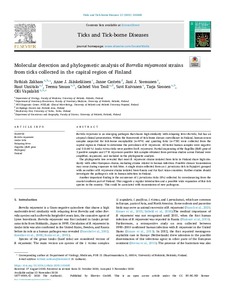Molecular detection and phylogenetic analysis of Borrelia miyamotoi strains from ticks collected in the capital region of Finland
Zakham Fathiah; Jääskeläinen Anne J.; Castrén Janne; Sormunen Jani J.; Uusitalo Ruut; Smura Teemu; Von Troil Gabriel; Kuivanen Suvi; Sironen Tarja; Vapalahti Olli
https://urn.fi/URN:NBN:fi-fe2021042820789
Tiivistelmä
Borrelia miyamotoi is an emerging pathogen that shares high similarity with relapsing fever Borrelia, but has an atypical clinical presentation. Within the framework of tick-borne disease surveillance in Finland, human serum samples suspected for tick-borne encephalitis (n=974) and questing ticks (n=739) were collected from the capital region in Finland to determine the prevalence of B. miyamotoi. All tested human samples were negative and 5 (0.68 %) Ixodes ricinus ticks were positive for B. miyamotoi. Partial sequencing of the flagellin (flaB) gene of 3 positive samples and 27 B. miyamotoi-positive tick samples obtained from previous studies across Finland were amplified, sequenced, and included in the phylogenetic analysis.
The phylogenetic tree revealed that most B. miyamotoi strains isolated from ticks in Finland share high similarity with other European strains, including strains related to human infection. Possible disease transmission may occur during exposure to tick bites. A single strain collected from an I. persulcatus tick in Pajujärvi grouped with an outlier of B. miyamotoi strains isolated from Russia and Far East Asian countries. Further studies should investigate the pathogen’s role in human infection in Finland.
Another important finding is the occurrence of I. persulcatus ticks (8%) collected by crowdsourcing from the coastal southern part of Finland. This suggests a regular introduction and a possible wide expansion of this tick species in the country. This could be associated with transmission of new pathogens.
Kokoelmat
- Rinnakkaistallenteet [27094]
